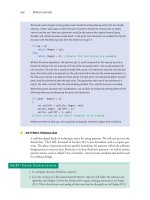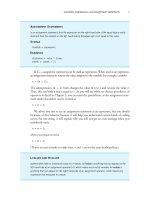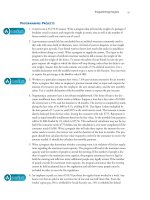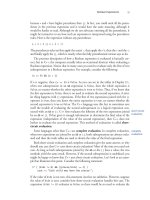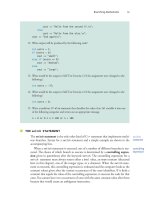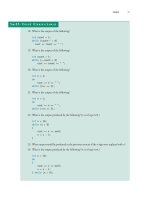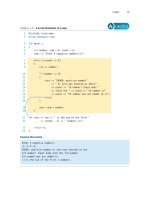Absolute C++ (4th Edition) part 10 potx
Bạn đang xem bản rút gọn của tài liệu. Xem và tải ngay bản đầy đủ của tài liệu tại đây (195.45 KB, 10 trang )
3
Function Basics
Good things come in small packages.
Common saying
INTRODUCTION
If you have programmed in some other language, then the contents of this
chapter will be familiar to you. You should still scan this chapter to see the C++
syntax and terminology for the basics of functions. Chapter 4 contains the
material on functions that might be different in C++ than in other languages.
A program can be thought of as consisting of subparts such as obtaining
the input data, calculating the output data, and displaying the output data.
C++, like most programming languages, has facilities to name and code each
of these subparts separately. In C++ these subparts are called
functions
. Most
programming languages have functions or something similar to functions,
although they are not always called by that name in other languages. The
terms
procedure
,
subprogram
, and
method
, which you may have heard before,
mean essentially the same thing as
function
. In C++ a function may return a
value (produce a value) or may perform some action without returning a
value, but whether the subpart returns a value or not, it is still called a func-
tion in C++. This chapter presents the basic details about C++ functions.
Before telling you how to write your own functions, we will first tell you how
to use some predefined C++ functions.
Predefined Functions
Do not reinvent the wheel.
Common saying
C++ comes with libraries of predefined functions that you can use in your
programs. There are two kinds of functions in C++: functions that return
(produce) a value and functions that do not return a value. Functions that do
not return a value are called
void
functions
. We first discuss functions that
return a value and then discuss
void
functions.
■
PREDEFINED FUNCTIONS THAT RETURN A VALUE
We will use the
sqrt
function to illustrate how you use a predefined function
that returns a value. The
sqrt
function calculates the square root of a number.
3.1
void
function
Predefined Functions 93
(The square root of a number is that number which when multiplied by itself will pro-
duce the number you started out with. For example, the square root of 9 is 3 because 3
2
is equal to 9.) The function
sqrt
starts with a number, such as 9.0, and computes its
square root, in this case 3.0. The value the function starts out with is called its
argu-
ment
. The value it computes is called the
value returned.
Some functions may have
more than one argument, but no function has more than one value returned.
The syntax for using functions in your program is simple. To set a variable named
theRoot
equal to the square root of
9.0
, you can use the following assignment statement:
theRoot = sqrt(9.0);
The expression
sqrt(9.0)
is known as a
function call
or
function invocation
. An
argument in a function call can be a constant, such as
9.0
, a variable, or a more compli-
cated expression. A function call is an expression that can be used like any other expres-
sion. For example, the value returned by
sqrt
is of type
double
; therefore, the following
is legal (although perhaps stingy):
bonus = sqrt(sales)/10;
sales
and
bonus
are variables that would normally be of type
double
. The function call
sqrt(sales)
is a single item, just as if it were enclosed in parentheses. Thus, the above
assignment statement is equivalent to
bonus = (sqrt(sales))/10;
You can use a function call wherever it is legal to use an expression of the type specified
for the value returned by the function.
Display 3.1 contains a complete program that uses the predefined function
sqrt
.
The program computes the size of the largest square doghouse that can be built for the
amount of money the user is willing to spend. The program asks the user for an
amount of money and then determines how many square feet of floor space can be pur-
chased for that amount. That calculation yields an area in square feet for the floor of
the doghouse. The function
sqrt
yields the length of one side of the doghouse floor.
The
cmath
library contains the definition of the function
sqrt
and a number of
other mathematical functions. If your program uses a predefined function from some
library, then it must contain an
include
directive that names that library. For example,
the program in Display 3.1 uses the
sqrt
function and so it contains
#include <cmath>
This particular program has two
include
directives. It does not matter in what order
you give these two
include
directives.
include
directives were discussed in Chapter 1.
Definitions for predefined functions normally place these functions in the
std
namespace and so also require the following
using
directive, as illustrated in Display 3.1:
using namespace std;
argument
value
returned
function
call or
function
invocation
#include
directive
94 Function Basics
Usually, all you need do to use a library is to place an
include
directive and a
using
directive for that library in the file with your program. If things work with just these
directives, you need not worry about doing anything else. However, for some libraries
on some systems you may need to give additional instructions to the compiler or
explicitly run a linker program to link in the library. The details vary from one system
to another; you will have to check your manual or a local expert to see exactly what is
necessary.
A few predefined functions are described in Display 3.2. More predefined functions
are described in Appendix 4. Notice that the absolute value functions
abs
and
labs
are
Display 3.1 A Predefined Function That Returns a Value
1 //Computes the size of a doghouse that can be purchased
2 //given the user’s budget.
3 #include <iostream>
4 #include <cmath>
5 using namespace std;
6 int main( )
7 {
8 const double COST_PER_SQ_FT = 10.50;
9 double budget, area, lengthSide;
10 cout << "Enter the amount budgeted for your doghouse $";
11 cin >> budget;
12 area = budget/COST_PER_SQ_FT;
13 lengthSide = sqrt(area);
14 cout.setf(ios::fixed);
15 cout.setf(ios::showpoint);
16 cout.precision(2);
17 cout << "For a price of $" << budget << endl
18 << "I can build you a luxurious square doghouse\n"
19 << "that is " << lengthSide
20 << " feet on each side.\n";
21 return 0;
22 }
S
AMPLE
D
IALOGUE
Enter the amount budgeted for your doghouse $25.00
For a price of $25.00
I can build you a luxurious square doghouse
that is 1.54 feet on each side.
#include
may not be
enough
abs and labs
Predefined Functions 95
in the library with header file
cstdlib
, so any program that uses either of these func-
tions must contain the following directive:
#include <cstdlib>
Also notice that there are three absolute value functions. If you want to produce the
absolute value of a number of type
int
, use
abs
; if you want to produce the absolute
value of a number of type
long
, use
labs
; and if you want to produce the absolute value
of a number of type
double
, use fabs. To complicate things even more, abs and labs
are in the library with header file cstdlib, whereas fabs is in the library with header
file
cmath. fabs is an abbreviation for floating-point absolute value. Recall that numbers
with a fraction after the decimal point, such as numbers of type
double, are often called
floating-point numbers.
Another example of a predefined function is
pow, which is in the library with header
file
cmath. The function pow can be used to do exponentiation in C++. For example, if
you want to set a variable
result equal to
x
y
, you can use the following:
result = pow(x, y);
Hence, the following three lines of program code will output the number 9.0 to the
screen, because
(3.0)
2.0
is 9.0:
double result, x = 3.0, y = 2.0;
result = pow(x, y);
cout << result;
F
UNCTIONS
T
HAT
R
ETURN
A
V
ALUE
For a function that returns a value, a function call is an expression consisting of the function name
followed by arguments enclosed in parentheses. If there is more than one argument, the argu-
ments are separated by commas. If the function call returns a value, then the function call is an
expression that can be used like any other expression of the type specified for the value returned
by the function.
S
YNTAX
Function_Name
(
Argument_List
)
where the
Argument_List
is a comma-separated list of arguments:
Argument_1
,
Argument_2
,. . .,
Argument_Last
E
XAMPLES
side = sqrt(area);
cout << "2.5 to the power 3.0 is "
<< pow(2.5, 3.0);
fabs
pow
96 Function Basics
Notice that the previous call to pow returns 9.0, not 9. The function pow always
returns a value of type
double, not of type int. Also notice that the function pow
requires two arguments. A function can have any number of arguments. Moreover,
every argument position has a specified type, and the argument used in a function call
should be of that type. In many cases, if you use an argument of the wrong type, some
automatic type conversion will be done for you by C++. However, the results may not
be what you intended. When you call a function, you should use arguments of the type
specified for that function. One exception to this caution is the automatic conversion
of arguments from type
int to type double. In many situations, including calls to the
Display 3.2 Some Predefined Functions
All these predefined functions require
using namespace std; as well as an include directive.
NAME DESCRIPTION TYPE OF
ARGUMENTS
TYPE OF
VALUE
RETURNED
EXAMPLE VALUE LIBRARY
HEADER
sqrt
Square root
double double sqrt(4.0) 2.0 cmath
pow
Powers
double double pow(2.0,3.0) 8.0 cmath
abs
Absolute
value for
int
int int abs(-7)
abs(7)
7
7
cstdlib
labs
Absolute
value for
long
long long labs(-70000)
labs(70000)
70000
70000
cstdlib
fabs
Absolute
value for
double
double double fabs(-7.5)
fabs(7.5)
7.5
7.5
cmath
ceil
Ceiling
(round up)
double double ceil(3.2)
ceil(3.9)
4.0
4.0
cmath
floor
Floor
(round
down)
double double floor(3.2)
floor(3.9)
3.0
3.0
cmath
exit
End program
int void exit(1);
None
cstdlib
rand
Random
number
None
int rand( )
Varies
cstdlib
srand
Set seed
for
rand
unsigned
int
void srand(42);
None
cstdlib
arguments
have a type
Predefined Functions 97
function pow, you can safely use an argument of type int (or other integer type) when
an argument of type
double (or other floating-point type) is specified.
Many implementations of
pow have a restriction on what arguments can be used. In
these implementations, if the first argument to
pow is negative, then the second argu-
ment must be a whole number. It might be easiest and safest to use
pow only when the
first argument is nonnegative.
■
PREDEFINED
void
FUNCTIONS
A void function performs some action, but does not return a value. Since it performs
an action, a
void function invocation is a statement. The function call for a void func-
tion is written similar to a function call for a function that returns a value, except that it
is terminated with a semicolon and is used as a statement rather than as an expression.
Predefined
void functions are handled in the same way as predefined functions that
return a value. Thus, to use a predefined
void function, your program must have an
include directive that gives the name of the library that defines the function.
For example, the function
exit is defined in the library cstdlib, and so a program
that uses that function must contain the following at (or near) the start of the file:
#include <cstdlib>
using namespace std;
The following is a sample invocation (sample call) of the function exit:
exit(1);
void
F
UNCTIONS
A void function performs some action, but does not return a value. For a void function, a func-
tion call is a statement consisting of the function name followed by arguments enclosed in paren-
theses and then terminated with a semicolon. If there is more than one argument, the arguments
are separated by commas. For a
void function, a function invocation (function call) is a state-
ment that can be used like any other C++ statement.
S
YNTAX
Function_Name
(
Argument_List
);
where the
Argument_List
is a comma-separated list of arguments:
Argument_1
,
Argument_2
, . . . ,
Argument_Last
E
XAMPLE
exit(1);
restrictions
on
pow
exit
98 Function Basics
An invocation of the exit function ends the program immediately. Display 3.3 con-
tains a toy program that demonstrates the
exit function.
Note that the function
exit has one argument, which is of type int. The argument
is given to the operating system. As far as your C++ program is concerned, you can use
T
HE
exit
F
UNCTION
The exit function is a predefined void function that takes one argument of type int. Thus, an
invocation of the
exit function is a statement written as follows:
exit(
Integer_Value
);
When the exit function is invoked (that is, when the above statement is executed), the program
ends immediately. Any
Integer_Value
may be used, but by convention, 1 is used for a call to
exit that is caused by an error, and 0 is used in other cases.
The
exit function definition is in the library cstdlib and it places the exit function in the std
namespace. Therefore, any program that uses the
exit function must contain the following two
directives:
#include <cstdlib>
using namespace std;
Display 3.3 A Function Call for a Predefined void Function
1 #include <iostream>
2 #include <cstdlib>
3 using namespace std;
4 int main( )
5 {
6 cout << "Hello Out There!\n";
7 exit(1);
8 cout << "This statement is pointless,\n"
9 << "because it will never be executed.\n"
10 << "This is just a toy program to illustrate exit.\n";
11 return 0;
12 }
S
AMPLE
D
IALOGUE
Hello Out There!
This is just a toy example. It
would produce the same output
if you omitted these lines.
Predefined Functions 99
Self-Test Exercises
any int value as the argument, but by convention, 1 is used for a call to exit that is
caused by an error, and
0 is used in other cases.
A
void function can have any number of arguments. The details on arguments for
void functions are the same as they were for functions that return a value. In particular,
if you use an argument of the wrong type, then, in many cases, some automatic type
conversion will be done for you by C++. However, the results may not be what you
intended.
1. Determine the value of each of the following arithmetic expressions.
2. Convert each of the following mathematical expressions to a C++ arithmetic expression.
3. Write a complete C++ program to compute and output the square roots of the whole num-
bers from 1 to 10.
4. What is the function of the
int argument to the void function exit?
■
A RANDOM NUMBER GENERATOR
A random number generator is a function that returns a “randomly chosen” number. It
is unlike the functions we have seen so far in that the value returned is not determined
by the arguments (of which there are usually none) but rather by some global condi-
tions. Since you can think of the value returned as being a random number, you can
use a random number generator to simulate random events, such as the result of throw-
ing dice or flipping a coin. In addition to simulating games of chance, random number
generators can be used to simulate things that strictly speaking may not be random but
that appear to us to be random, such as the amount of time between the arrival of cars
at a toll booth.
sqrt(16.0) sqrt(16) pow(2.0, 3.0)
pow(2, 3) pow(2.0, 3) pow(1.1, 2)
abs(3) abs(-3) abs(0)
fabs(-3.0) fabs(-3.5) fabs(3.5)
ceil(5.1) ceil(5.8) floor(5.1)
floor(5.8) pow(3.0, 2)/2.0 pow(3.0, 2)/2
7/abs(-2) (7 + sqrt(4.0))/3.0 sqrt(pow(3, 2))
a. b. c.
d. e. f.
xy+
x
y 7+
area fudge+
time tide+
nobody
bb
2
4ac–+–
2a
xy–
100 Function Basics
The C++ library with header file <cstdlib> contains a random number function
named
rand. This function has no arguments. When your program invokes rand, the
function returns an integer in the range
0 to RAND_MAX, inclusive. (The number gener-
ated might be equal to
0 or RAND_MAX.) RAND_MAX is a defined integer constant whose
definition is also in the library with header file
<cstdlib>. The exact value of RAND_MAX
is system-dependent but will always be at least 32767 (the maximum two-byte positive
integer). For example, the following outputs a list of ten “random” numbers in the
range
0 to RAND_MAX:
int i;
for (i = 0; i < 10; i++)
cout << rand( ) << endl;
You are more likely to want a random number in some smaller range, such as the
range 0 to 10. To ensure that the value is in the range 0 to 10 (including the end
points), you can use
rand( ) % 11
This is called scaling. The following outputs ten “random” integers in the range 0 to
10 (inclusive):
int i;
for (i = 0; i < 10; i++)
cout << (rand( ) % 11) << endl;
Random number generators, such as the function rand, do not generate truly ran-
dom numbers. (That’s the reason for all the quotes around “random.”) A sequence of
calls to the function
rand (or almost any random number generator) will produce a
sequence of numbers (the values returned by
rand) that appear to be random. How-
ever, if you could return the computer to the state it was in when the sequence of calls
to
rand began, you would get the same sequence of “random numbers.” Numbers that
appear to be random but really are not, such as a sequence of numbers generated by
calls to
rand, are called pseudorandom numbers.
A sequence of pseudorandom numbers is usually determined by one number known
as the seed. If you start the random number generator with the same seed, over and
over, then each time it will produce the same (random-looking) sequence of numbers.
You can use the function
srand to set the seed for the function rand. The void function
srand takes one (positive) integer argument, which is the seed. For example, the follow-
ing will output two identical sequences of ten pseudorandom numbers:
int i;
srand(99);
for (i = 0; i < 10; i++)
cout << (rand( ) % 11) << endl;
srand(99);
for (i = 0; i < 10; i++)
cout << (rand( ) % 11) << endl;
rand
RAND_MAX
scaling
pseudorandom
number
seed
srand
Predefined Functions 101
There is nothing special about the number 99, other than the fact that we used the
same number for both calls to
srand.
Note that the sequence of pseudorandom numbers produced for a given seed might
be system-dependent. If rerun on a different system with the same seed, the sequence
of pseudorandom numbers might be different on that system. However, as long as you
are on the same system using the same implementation of C++, the same seed will pro-
duce the same sequence of pseudorandom numbers.
These pseudorandom numbers are close enough to true random numbers for most
applications. In fact, they are often preferable to true random numbers. A pseudoran-
dom number generator has one big advantage over a true random number generator:
The sequence of numbers it produces is repeatable. If run twice with the same seed
value, it will produce the same sequence of numbers. This can be very handy for a
number of purposes. When an error is discovered and fixed, the program can be rerun
with the same sequence of pseudorandom numbers as those that exposed the error.
Similarly, a particularly interesting run of the program can be repeated, provided a
pseudorandom number generator is used. With a true random number generator every
run of the program is likely to be different.
Display 3.4 shows a program that uses the random number generator
rand to “pre-
dict
” the weather. In this case the prediction is random, but some people think that is
about as good as weather prediction gets. (Weather prediction can actually be very
accurate, but this program is just a game to illustrate pseudorandom numbers.)
Note that in Display 3.4, the seed value used for the argument of
srand is the
month times the day. That way if the program is rerun and the same date is entered, the
same prediction will be made. (Of course, this program is still pretty simple. The pre-
diction for the day after the 14th may or may not be the same as the 15th, but this pro-
gram will do as a simple example.)
Probabilities are usually expressed as a floating-point number in the range 0.0 to
1.0. Suppose you want a random probability instead of a random integer. This can be
P
SEUDORANDOM
N
UMBERS
The function rand takes no arguments and returns a pseudorandom integer in the range 0 to
RAND_MAX (inclusive). The void function srand takes one argument, which is the seed for the
random number generator
rand. The argument to srand is of type unsigned int, so the argu-
ment must be nonnegative. The functions
rand and srand, as well as the defined constant
RAND_MAX, are defined in the library cstdlib, so programs that use them must contain the
following directives:
#include <cstdlib>
using namespace std;
floating-
point
random
numbers
